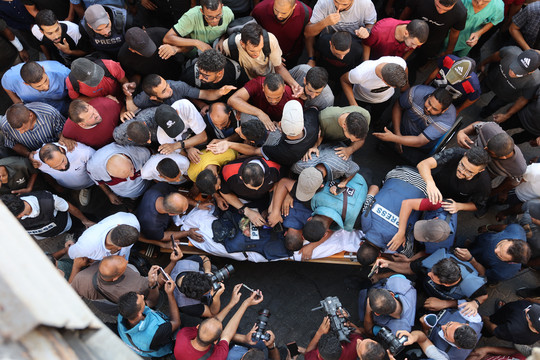Unusually, we know that the killing was deliberate – because the Israeli Defence Force (IDF) has admitted that it was.
The Israeli military justified the assassination alleging that the journalists’ name appears on a roll call of ‘senior Hamas officers’ captured earlier in the war. This is strenuously denied by al-Ghoul’s family, his employer and his union. And, IDF ‘evidence’ in previous cases has appeared questionable. Indeed, Al-Ghoul spent enough time ‘on camera’ that his capacity outside journalism would have been limited.
Most important of all, however, Israeli soldiers arrested al-Ghoul in March and held him for 12 hours. There are accusations that he was assaulted while detailed. He was, however, released without charge. If the evidence of his Hamas’ membership justified his killing, the surely there must have been sufficient basis for his prosecution?
This admission of targeting confirms troubling allegations about IDF operations that have circulated for months. It has software – Pegasus – that secretly invades mobile phones and shares its user’s locations, communications and the identities of those who they meet.
The IDF use a program called ‘Lavender’ that deploys AI to asses operational intelligence and suggest targets for assassination. A further tool, ‘The Gospel’, uploads targets’ geo locations to killer drones far faster than had been possible with manual programming.
Aside from the technology, there is also the extraordinary number of Gazan journalists killed since 7 October. A cautious tally puts this at around 120, others say that as many as 165 media workers have perished in the enclave since 7 October. The total death toll in this war is far, far greater, of course, around 40,000 have lost their lives. It is the mortality rate among journalists that is really striking, however. Approximately 1,000 journalists were at work in Gaza at the start of the conflict – more than 12 per cent have now died – many more are injured or have lost family members.
Precision targeting and the extraordinary rate of killing, points to a simple and awful conclusion about the IDF’s methods. But there is more.
Since the outset of the conflict the Israeli government excluded international reporters from entering Gaza – despite hundreds trying to enter the enclave. It’s ministers have also: threatened to remove funding from newspapers such as Haaretz, shut down Al Jazeera’s operation in Israel, and deactivated the internet at key moments.
Nor is respect for international law the IDF way. When the United Nations investigated the killing of Shireen Abu Akleh – killed in the West Bank in 2022 – its report concluded: “the the Israeli security forces used lethal force without justification under international human rights law and intentionally or recklessly violated the right to life of Shireen Abu Akleh”.
But why target journalist in this way? The only plausible explanation is that this is an attempt to control the war narrative, and show that the IDF takes out civilian targets at will.
International law requires that journalists are considered civilians and combatants are obliged to ensure their safety. The IDF’s bloody campaign clearly contravenes this – but will the institutions of international law will bring anyone to justice? The International Criminal Court’s lead prosector, Karim Khan showed considerable bravery in May by issuing arrest warrants for the Israeli and Hamas leadership.
Should he see these cases through to satisfactory conclusions he will have shown himself as one of the greatest jurists of our age.
Justice won’t bring back al-Ghoul and al-Rifi, of course. They have, however, distinguished themselves by standing up to the most horrific force ever visited upon journalists and continuing to act as the world’s eyes and ears. There is no consolation for them – but they deserve celebration; their colleagues who continue this work deserve our support.
Tim Dawson is deputy general secretary of the International Federation of Journalists (IFJ).

